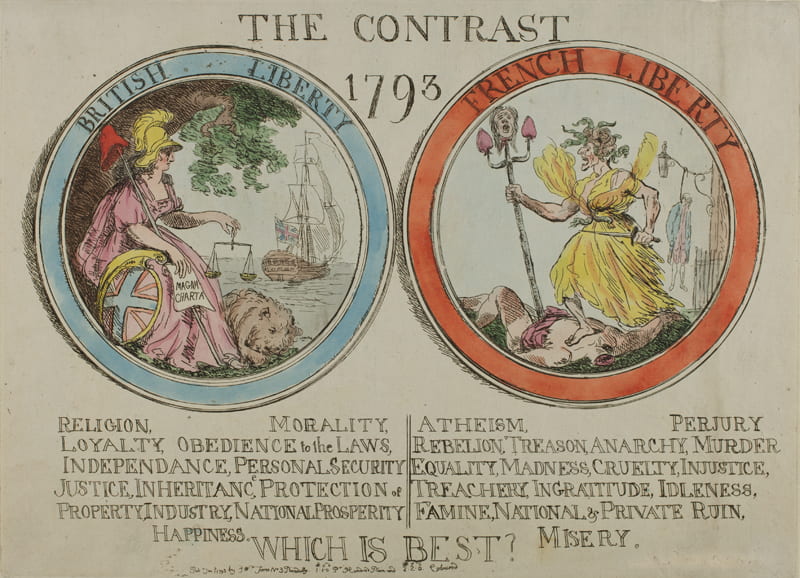Object of the week 382: Isaac Cruikshank, French Happiness, English Misery (1793)
By Nina Pearlman, on 24 May 2019
This blog post is written by Lisa Bull, UCL Museum Studies 2019-20
UCL Art Museum is home to an impressive collection of French and British satires from the eighteenth and nineteenth century. This collection is the result of a generous gift by Professor David Bindman made possible through the Cultural Gift Scheme and it forms the basis for a series of exhibitions on visual satires chronicling the French Revolution. The new addition to this series will be Witnessing Terror: French Revolutionary Prints 1792-4 due to open at UCL Art Museum in January 2020.
In the eighteenth and nineteenth centuries satire was the key means to spread news. Satire was and still is an effective means of stimulating debate due to its accessibility. Their intention to have a clear message and the relatively quick method of production meant they could be enjoyed by many. They are often aimed at ridiculing an individual, policy or group in society but while retaining an important moral message. Satires are still a key form of media utilised in most news forums, but here in the twenty-first century social media has filled this gap and is essential for us to keep in touch with current affairs.
My role is to help catalogue the works by British satirists in this collection, such as William Hogarth, James Gillray, Isaac Cruikshank, Thomas Rowlandson and Charles Jameson Grant. Since March I have been measuring and researching this body of works as part of a placement that is part of my MA course in Museum Studies at UCL. I am particularly interested in curation and interpretation; I hope to be part of the process of interpreting collections for audiences and making them accessible. This placement has given me the opportunity to learn more about the process of preparing for an exhibition, the activity of accessioning objects, condition checking and researching. In the future I also hope to contribute to creating a new teaching pack to coincide with the Witnessing Terror exhibition. It has been rewarding learning more about satirical prints. The prints are incredibly detailed, clever and witty. They are extremely eye-catching to audiences as they intend to be striking and graphic.
While researching the satires from Bindman’s collection, I made a note of some that particularly caught my eye:
A leading favourite is Isaac Cruikshank’s French Happiness, English Misery (1793) follows a popular theme of comparing the British and French in the same print. There is an incredible amount of detail in this print. On the left are four Frenchmen fighting over one frog, their clothes are in tatters. Images of death surround them. In the background is the outline of a man hanging from a lamppost and a head is impaled on the end of a baronet. On the wall is a list of the numbers of French soldiers killed. Whereas on the right, titled English Misery there are several references to prosperity. Four Englishmen stuff themselves with meat and ale. Outside there is evidence of bountiful food produce. A man is sowing the fields and an apple tree is protruding into the room. Even the animals at the men’s feet are well-fed. It suggests the revolutionaries idea of ‘happiness’ is immoral and savage, suggesting they are not fighting for the English morals of liberty. This print acts as a deterrent, it is a warning to not follow the French but to uphold British ideals.
Another notable print that compares British and French notions of liberty is Thomas Rowlandson’s The Contrast published a year earlier in 1892.
This is the first post of a series in the build up to Witnessing Terror: French Revolutionary Prints 1792-4.
2 Responses to “Object of the week 382: Isaac Cruikshank, French Happiness, English Misery (1793)”
- 1
-
2
Lisa Randisi wrote on 21 April 2021:

Hi Kate –
You could buy these prints in print shops, even at your local barber. The prints often tell you along the bottom where they could be bought, and for how much.
 Close
Close




I’m curious: where would the people come across these images?